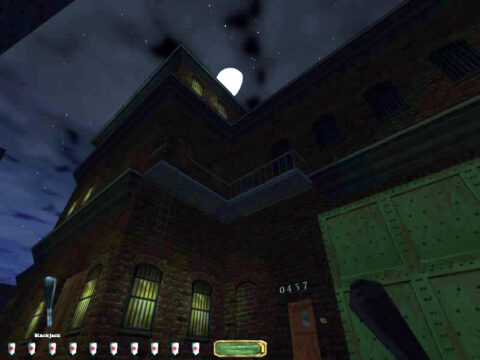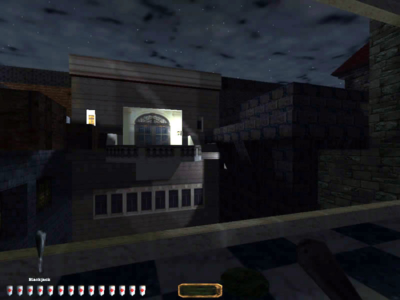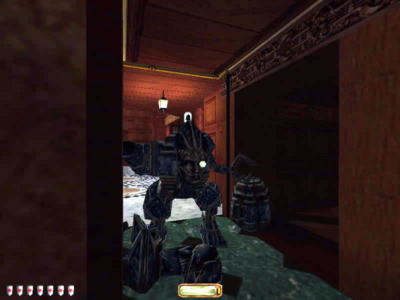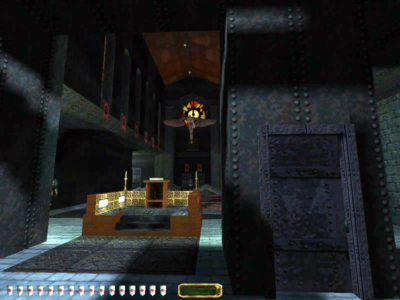
Thief 2: The Metal Age
Written by: Stoo
Date posted: December 3, 2005
- Genre: Action
- Developed by:
- Published by: Eidos
- Year released: 2000
- Our score: 10
Thief: The Dark Project was the quiet classic of 1998. With it, Looking Glass Studios brought us a whole new kind first-person gaming, based on stealth and sneaking. While other games saw you dashing around shooting aliens, Thief was a slow and cautious affair, with an emphasis on avoiding fighting. Lurking in the shadows, padding softly past oblivious guards, and occasionally clobbering them over the head from behind. Thief wasn’t a huge hit on the scale of Half-Life, but it gained a loyal following with one of the most immersive gaming experiences ever seen, and was deemed successful enough to warrant a sequel.
Once again you take on the role of Garrett, the greatest thief the world has never seen. The best guarded mansions and the most secure of vaults still aren’t safe from the master thief, in his pursuit of riches. Following his adventures saving his city in the previous game, Garrett has had enough of heroics. He’s quite content to stick to looting gold, jewels and treasures from the wealthy, and saving up for his comfortable retirement. Unfortunately for him, life is never that simple. As the Metal Age dawns upon the (still un-named) city, his former mentors the Keepers are back and pestering him with talk of prophecy again.
For much of this game, then, it’s business as usual for Garrett. Same engine, slightly improved graphics, same gameplay. The business of sneaking and avoiding alerting your enemies functions just as before, and fans of the original can step right in without even consulting the manual. The first step to avoiding your enemy is to stay out of the light, with a “light gem” on the interface warning you as to how well illuminated you currently are. Next step is to stay quiet, paying attention to what kind of surface you’re moving along and avoiding actions that might draw attention to yourself. Finally, you must keep an eye on guards, plan your moves to get past their patrols, and learn to be even more careful when they’re at a higher state of alert.
What has changed this time around is the environment. The first game had much of its roots in medieval and fantastical themes, but there were also in the background signs of industry and technology, such as electric lighting. This is greatly expanded upon in the sequel, with the coming of a new faction in the city. A splinter group of the dour Hammerites, they call themselves Mechanists and have brought with them amazing new technologies.
It’s very much in the style known as Steampunk, a type of fantasy setting where devices produce modern functions like robotics or submarines, but with their basis in principles like like steam power and a basic grasp of electricity. Opinions are divided on how well it fits into the Thief world but as for me, I’m happy enough with the change of direction. It’s just a new flavour of creepiness for the game to deliver.
Apart from amazing new machinery, there have been some subtle shifts in the wider world. It almost feels more victorian than medieval in places; and sometimes even goes a little art deco on us. Where Thief began with grimy stone and wood, this one adds a dose of brickwork and steel. Yet people still dress in an olde worlde style the guards still carry swords. It’s like a collisions of two different periods of earth history, with the progress driven by religious fundamentalists, and quite unique in feel.
Aesthetics aside, I must move onto gameplay. A criticism often levelled at the original Thief, is that that it didn’t stick to the supposed core premise. It laid down a style of gaming based on breaking into mansions and looting the contents, but then deviated from that format. Many missions pitted you against the undead or other creatures, and saw you exploring more fantasy-style locations such as zombie-infested crypts and magical labyrnths. Personally I have no problems with that; hiding from monsters in haunted ruins can be just as atmospheric and exciting as hiding from guards in a mansion. It was only towards the end that the game that you found yourself running away from (or desperately swinging your sword at) pagan monsters more than doing any proper looting. At any rate, it seems Looking Glass took the criticisms on board for the second time round. Thief 2 sticks closer to that core theme of finding your way into some building in the city, stealing loot and getting out again. Also, undead creatures like zombies play a far smaller role this time.
That’s not to say you’re only up against human enemies, however, as the Mechanists bring with them a whole new range of threats to Garret. Most prominent are the steam-powered robots, clumsy walking boilers that squawk religious babble whilst launching bombs at you. There are also security cameras, fashioned in the form of brass faces, that will sound an alert and also trigger static turrets. Such threats are tricky to disable, forcing you more than ever to stay the hell away from a fight. You have to either either sneak up and exploit a weakness, or just avoid them altogether. It’s a whole new experience taking on these soulless brass automatons, and just as much fun as the other threats you might face.
Garrett also has some new toys of his own, along with all the old favourites like Water Arrows and flashbombs. His mechanical eye with a handy zoom function allows you to scope out hazards or potential loot from a safe distance. It also links up to scouting orbs which are essentially remote cameras, and can be tossed around a corner or over a wall to see what’s there without putting yourself at risk. For entertainment value there are frogbeast eggs, which distract your enemies and then self-destruct in a wet and froggy manner.
The level design meanwhile is up to the high standards of the first game. A number of missions are set around a single large structure such as a mansion or bank; in true Thief style there are usually several ways in for the clever and observant sneaker. A couple more give you a large area of city streets to explore; sadly most buildings here are inaccessible but there’s still an impressive sense of scale. The huge maps dwarf the tiny enclosed areas produced in some more modern games. Perhaps the best of the lot sees you taking the “thieves highway” along the rooftops, scrambling from one building to the next to crash a party at the Mechanist headquarters. For a bit of variety, one mission even manages a decent attempt at producing a forest environment. Once again this isn’t a game of linear paths through missions; most maps are open to you to explore freely and track down loot.
The biggest weakness perhaps is one that Looking Glass pretty much admitted themselves: they designed the missions first, then built a story around it. Thus that story feels a little contrived, especially towards the end with some rather awkward bits of narrative trying to link the missions together. Still, factors like the soundtrack, animated cutscenes and voice acting are just as excellent as before. Stephen Russel once again brings the sardonic Garrett to life as the protagonist. He’s not so much a dark anti-hero as a professional who tries his best (and fails) to remain amoral and self-serving. A few other familiar faces return from the first game including the fan’s favourite, drunk and oafish guard Benny.
All in all, The Metal Age was a worthy successor to its revered predecessor. Fans like to argue over which is the better, but that really comes down to personal preference. Do you prefer a grimy, decayed, world with a dark and arcane feel? Or one that’s more a kind of victorian-medieval crossbreed with added steampunk? Either way, the main elements that make Thief so great are present. There’s the patient waiting in the shadows, pondering where to go next and how the avoid the guards. Exploring the length and breadth of every map for hidden passageways and secret loot. The feeling of quiet tension. Grinning as you find a cache of gold, and then sprinting for your life with angry guards in tow. It’s all quality thieving action, that you won’t get anywhere else.





 Posts
Posts